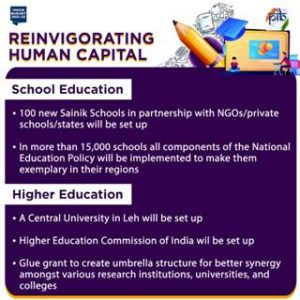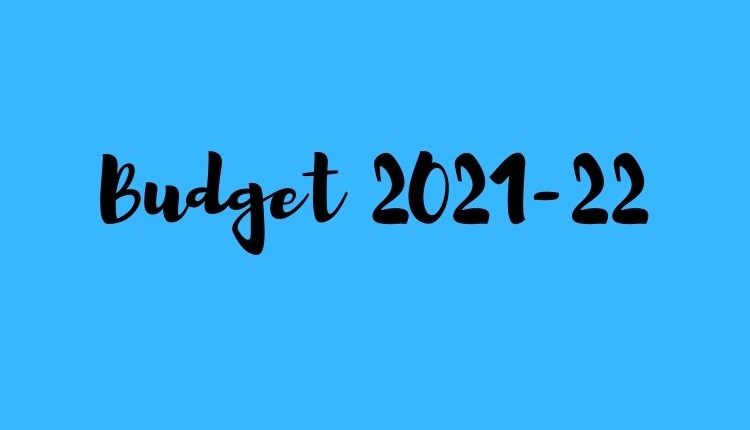Wondering how will the budget impact education sector? Well, read below what all budget 2021-22 has to offer to the education sector:
Highlights of Budget 2021-22 – Department of School Education & Literacy
- The overall budget allocation in BE 2021-22 is Rs 54,873.66 crore out of which scheme allocation is Rs 43,648.66 crore and non-scheme allocation is Rs 11,225 crore. The scheme allocation has been increased by Rs 1,895.08 crore and non-scheme allocation by Rs 789.51 crore as compared to RE 2020-21.
- Budget allocation in the flagship scheme of Samagra Shikhsa has been increased to Rs 31,050.16 crore in BE 2021-22.
- The budget allocation in Padhna Likhna Abhiyan (PLA) is also increased from Rs 95.25 crore (RE 2020-21) to Rs 250 crore in BE 2021-22 (an increase of Rs 154.75 crore).
- Rs. 485 crore is also provisioned in the newly created centrally sponsored scheme of STARS.
- Allocation of KVS is increased by Rs 362.32 crore and allocation of NVS increased to Rs. 320 crore w.r.t. RE 2020-21.
- The budget allocation of NCERT increased to Rs 110.08 crore from RE 2020-21.
CBSE Board Exam reforms will be introduced in a phased manner to be effective from the 2022-23 academic session. Exams will move away from rote-learning and students shall be tested on their conceptual clarity, analytical skills and application of knowledge to real life situations
Initiatives on Education as part of NEP
- Standards will be developed for all school teachers in the form of National Professional Standards for Teachers – NPST. This will enhance the capabilities of teachers and will be followed by all 92 lakh teachers of public and private school system in the country.
- A unique indigenous toy-based learning pedagogy for all levels of school education will be developed. This will transform classroom transactions from mundane and rote learning to an engaging and joyful experience.
- A National Digital Educational Architecture (NDEAR) will be set up within the context of a Digital First Mindset where the Digital Architecture will not only support teaching and learning activities but also educational planning, governance and administrative activities of the Centre and the States/ Union Territories. It will provide a diverse education eco-system architecture for development of digital infrastructure, a federated but inter operable system that will ensure autonomy of all stakeholders, specially states and UTs.
- For children with hearing impairments, the government will work on standardisation of Indian Sign language across the country, and develop national and state curriculum materials for use by them.
- Senior and retired teachers will be used for individual mentoring of school teachers and educators through constant online/offline support on subjects, themes and pedagogy.
- Students have so far been evaluated on uni-dimensional parameters. There will be a complete shift from using assessments to not only judge the cognitive levels of the learner but also using it as an opportunity to identify the unique strengths and the potential of the child. To this effect, a holistic progress card is envisaged to provide students with valuable information on their strengths, areas of interest, needed areas of focus and thereby helping them in making optimal career choices.
- To enable increased access of resources, online modules covering the entire gamut of adult education will be introduced.
- During the year, despite the COVID-19 pandemic, more than 30 lakh elementary school teachers were trained digitally, covering the whole gamut of education. Taking this further, in 2021-22, 56 lakh school teachers will be trained through the National Initiative for School Heads and Teachers for Holistic Advancement (NISTHA).
- CBSE Board Exam reforms will be introduced in a phased manner to be effective from the 2022-23 academic session. Exams will move away from rote-learning and students shall be tested on their conceptual clarity, analytical skills and application of knowledge to real life situations.
- To promote enhanced academic collaboration with foreign higher educational institutions, a regulatory mechanism is proposed to be put in place to permit dual degrees, joint degrees, twinning arrangements and other such mechanisms.
 Highlights of Budget 2021-22 – Department of Higher Education
Highlights of Budget 2021-22 – Department of Higher Education
- BE for year 2021-22 has been kept at Rs 38,350.65 cr. Out of this, provisions for Establishment, Autonomous Bodies (ABs), and Schemes are
- Establishment: Rs 247.44 cr
- Autonomous Bodies: Rs 29,023.78 cr
- Schemes Total: Rs 9,069.43 cr
- Centrally Sponsored Schemes: Rs 3,000 cr [RUSA]
- Central Sector Schemes: Rs 6,069.43 cr
- For flagship scheme Rashtriya Uchchatar Shiksha Abhiyan (RUSA), a budget provision of Rs 3,000 cr has been kept for FY 2021-22.
- Budget allocation for the National Apprenticeship Training Scheme (NATS), has been substantially increased from Rs 175 cr to Rs 500 cr in FY 2021-22 for providing post-education apprenticeship, training of graduates and diploma holders in engineering.
- Some new Initiatives like – Opening of Bhartiya Bhasa University & Institute of Translation, Indian Knowledge System, Academic Bank of Credit, PM e-Vidya, Multidisciplinary Education and Research Improvement in Technical Education (MERITE) shall be implemented in line with the NEP recommendations, after approval of the competent authority. At present a token provision has been kept in the BE of FY 2021-22 for all the above initiatives.
Announcements:
- Higher Education Commission of India (HECI), an umbrella body, which will have 4 verticals – Accreditation, Standard Setting, Regulation and Funding. Legislation for HECI will be introduced this year.
- In nine cities where there are number of institutions supported by the GoI (like Hyderabad etc.). the government will create a formal umbrella structure for better synergy, while retaining their internal autonomy.
- A new Central University (CU) will be set up in Leh.
- Realignment of the existing scheme of National Apprenticeship Training Scheme (NATS) for providing post-education apprenticeship, training of graduates and diploma holders in engineering. Over Rs 3,000 crores will be provided for this in next 5 years.
- For promotion of Innovation and R&D, an outlay of Rs 50,000 cr over next 5 years has been kept for National Research Foundation (NRF). Its major beneficiaries will be Higher Education Institutions including CFTIs like IITs/IISc/IISERs/NITs etc.
Do you feel strongly about something? Have a story to share? Write to us at info@thepeepertimes.com or connect with us on Facebook or Twitter




Comments are closed, but trackbacks and pingbacks are open.